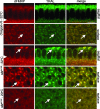Fragile X mental retardation protein controls trailer hitch expression and cleavage furrow formation in Drosophila embryos
- PMID: 17110444
- PMCID: PMC1838723
- DOI: 10.1073/pnas.0606508103
Fragile X mental retardation protein controls trailer hitch expression and cleavage furrow formation in Drosophila embryos
Abstract
During the cleavage stage of animal embryogenesis, cell numbers increase dramatically without growth, and a shift from maternal to zygotic genetic control occurs called the midblastula transition. Although these processes are fundamental to animal development, the molecular mechanisms controlling them are poorly understood. Here, we demonstrate that Drosophila fragile X mental retardation protein (dFMRP) is required for cleavage furrow formation and functions within dynamic cytoplasmic ribonucleoprotein (RNP) bodies during the midblastula transition. dFMRP is observed to colocalize with the cytoplasmic RNP body components Maternal expression at 31B (ME31B) and Trailer Hitch (TRAL) in a punctate pattern throughout the cytoplasm of cleavage-stage embryos. Complementary biochemistry demonstrates that dFMRP does not associate with polyribosomes, consistent with their reported exclusion from many cytoplasmic RNP bodies. By using a conditional mutation in small bristles (sbr), which encodes an mRNA nuclear export factor, to disrupt the normal cytoplasmic accumulation of zygotic transcripts at the midblastula transition, we observe the formation of giant dFMRP/TRAL-associated structures, suggesting that dFMRP and TRAL dynamically regulate RNA metabolism at the midblastula transition. Furthermore, we show that dFMRP associates with endogenous tral mRNA and is required for normal TRAL protein expression and localization, revealing it as a previously undescribed target of dFMRP control. We also show genetically that tral itself is required for cleavage furrow formation. Together, these data suggest that in cleavage-stage Drosophila embryos, dFMRP affects protein expression by controlling the availability and/or competency of specific transcripts to be translated.
Conflict of interest statement
The authors declare no conflict of interest.
Figures





References
Publication types
MeSH terms
Substances
Grants and funding
LinkOut - more resources
Full Text Sources
Other Literature Sources
Molecular Biology Databases

